abit IP35-Pro: Houston, We Have a Winner
by Gary Key on November 1, 2007 7:00 AM EST- Posted in
- Motherboards
abit IP35-Pro: Board Layout and Features
The abit engineers spent the proper amount of time on the layout of this board. The color scheme is simple and almost elegant when comparing it to some of the Crayola color schemes we have seen in the labs. The board was a snap to install in our Antec P180 and Cooler Master 830 cases with most connections easily reached. The board features a high quality four-phase voltage regulator system that provided excellent stability throughout testing. The board also utilizes Conductive Polymer Aluminum Solid Capacitors.
The IP35-Pro comes with six fan headers (1 x 4-pin, 5 x 3-pin) that provided an excellent balance of cooling options. Control of the individual fan headers is available via the BIOS and the µGuru program within Windows. Each header type has the three options of monitoring and control settings within the BIOS. abit utilizes a well-engineered heat pipe system for cooling the MCH, ICH, and PWM component areas.
Engineering can only take you so far, and unfortunately the execution is not always up to standards. Out of the three boards we tested, two had problems with the heatsink properly making contact on the PWM components and the MCH heatsink was not completely flat. A quick Google search will lead you to a forum user who "fixed" this problem. We tried it on one of our boards and noticed the MCH temperatures dropped 5C while PWM temperatures dropped over 9C when overclocking the board.
Around the CPU socket area, we find an ample amount of room for the majority of cooling solutions. We utilize the stock heatsink/fan in our base testing but also installed several aftermarket Socket-775 cooling solutions such as the Tuniq 120 and Thermalright Ultra 120 eXtreme during our overclocking tests. However, based upon our initial overclocking tests, if a vertical mounted fan in an air cooling unit such as the Tuniq 120 or water-cooling is utilized then additional air cooling will be required on the MCH and PWM areas. In other words, the heat pipe system works best with a downward blowing CPU HSF fan in mind.
The 8-pin ATX power connector is located on the edge of the board behind the PS/2 ports and did not interfere with our various cooling units. It is easy to remove the heat pipe system if you wish to water cool the MCH/ICH chipsets or perform the PWM heatsink mod.

The DIMM module slots' color coordination is correct for dual channel setup based upon the premise of installing DIMMs in the same colored slots for dual-channel operation. Installing memory modules will not be a problem, even with a full-size video card in the first PCI Express x16 slot. The 24-pin ATX power connector is located on the edge of the board along with the number three system fan header.
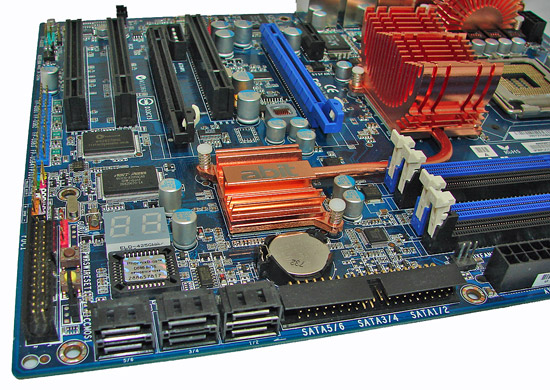
We found the positioning of the six black ICH9R SATA ports to be excellent when utilizing the expansion slots, as they are out of the way of most long cards. The ICH9R chipset uses passive cooling and was reasonably cool to the touch throughout testing. To the right of the SATA ports is the IDE connector and battery.
In a nod to those users who run their systems on an open platform or get tired of hooking up the chassis panel connections, abit has added power on and reset buttons on the board. These buttons have always been useful for us and should be standard on any board in this market segment. Of course, a POST Code Debug LED is included in typical abit style and the floppy drive connector is located next to it.
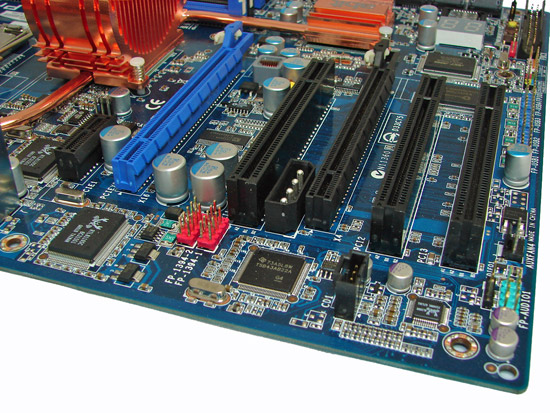
The board comes with two physical PCI Express x16 connectors (1 x16, 1 x4 electrical), one PCI Express x1 connector, and three PCI 2.3 connectors. A dual slot graphics card will block the second PCI slots. Several cards we tried in the PCI Express x1 slot had a tight fit with our 2900XT card installed. A 4-pin 12V Molex connector is to the right of the first PCI slot; CrossFire configurations (or systems where all of the expansion slots are populated) should use this extra power connector.
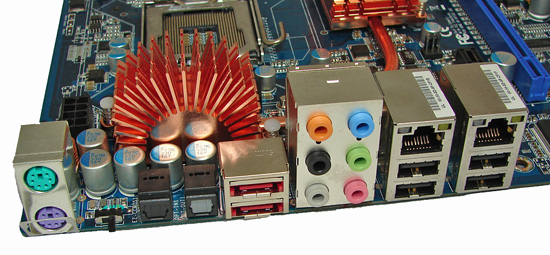
The rear panel contains the standard PS/2 mouse and keyboard ports. The panel also includes two RJ-45 LAN ports with activity indicator lights, four USB ports, and optical in/out S/PDIF ports. The audio panel consists of six ports that support 2, 4, 6, and 8-channel audio connections for the Realtek ALC888 HD codec. Finally, there are two eSATA ports along with a handy clear CMOS switch.
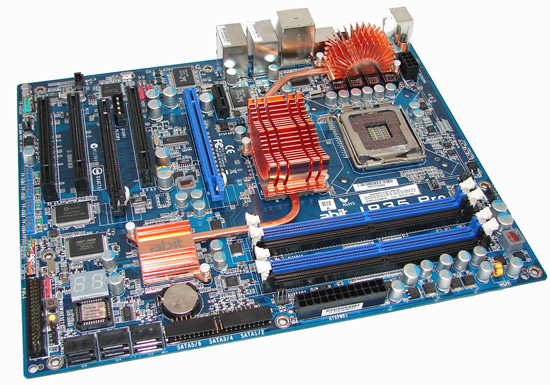 |
The abit engineers spent the proper amount of time on the layout of this board. The color scheme is simple and almost elegant when comparing it to some of the Crayola color schemes we have seen in the labs. The board was a snap to install in our Antec P180 and Cooler Master 830 cases with most connections easily reached. The board features a high quality four-phase voltage regulator system that provided excellent stability throughout testing. The board also utilizes Conductive Polymer Aluminum Solid Capacitors.
The IP35-Pro comes with six fan headers (1 x 4-pin, 5 x 3-pin) that provided an excellent balance of cooling options. Control of the individual fan headers is available via the BIOS and the µGuru program within Windows. Each header type has the three options of monitoring and control settings within the BIOS. abit utilizes a well-engineered heat pipe system for cooling the MCH, ICH, and PWM component areas.
Engineering can only take you so far, and unfortunately the execution is not always up to standards. Out of the three boards we tested, two had problems with the heatsink properly making contact on the PWM components and the MCH heatsink was not completely flat. A quick Google search will lead you to a forum user who "fixed" this problem. We tried it on one of our boards and noticed the MCH temperatures dropped 5C while PWM temperatures dropped over 9C when overclocking the board.
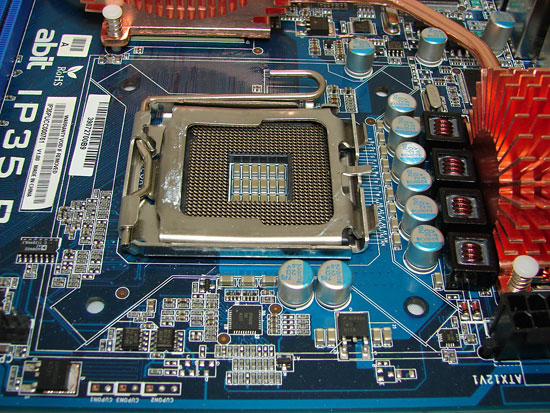 |
Around the CPU socket area, we find an ample amount of room for the majority of cooling solutions. We utilize the stock heatsink/fan in our base testing but also installed several aftermarket Socket-775 cooling solutions such as the Tuniq 120 and Thermalright Ultra 120 eXtreme during our overclocking tests. However, based upon our initial overclocking tests, if a vertical mounted fan in an air cooling unit such as the Tuniq 120 or water-cooling is utilized then additional air cooling will be required on the MCH and PWM areas. In other words, the heat pipe system works best with a downward blowing CPU HSF fan in mind.
The 8-pin ATX power connector is located on the edge of the board behind the PS/2 ports and did not interfere with our various cooling units. It is easy to remove the heat pipe system if you wish to water cool the MCH/ICH chipsets or perform the PWM heatsink mod.

The DIMM module slots' color coordination is correct for dual channel setup based upon the premise of installing DIMMs in the same colored slots for dual-channel operation. Installing memory modules will not be a problem, even with a full-size video card in the first PCI Express x16 slot. The 24-pin ATX power connector is located on the edge of the board along with the number three system fan header.

We found the positioning of the six black ICH9R SATA ports to be excellent when utilizing the expansion slots, as they are out of the way of most long cards. The ICH9R chipset uses passive cooling and was reasonably cool to the touch throughout testing. To the right of the SATA ports is the IDE connector and battery.
In a nod to those users who run their systems on an open platform or get tired of hooking up the chassis panel connections, abit has added power on and reset buttons on the board. These buttons have always been useful for us and should be standard on any board in this market segment. Of course, a POST Code Debug LED is included in typical abit style and the floppy drive connector is located next to it.

The board comes with two physical PCI Express x16 connectors (1 x16, 1 x4 electrical), one PCI Express x1 connector, and three PCI 2.3 connectors. A dual slot graphics card will block the second PCI slots. Several cards we tried in the PCI Express x1 slot had a tight fit with our 2900XT card installed. A 4-pin 12V Molex connector is to the right of the first PCI slot; CrossFire configurations (or systems where all of the expansion slots are populated) should use this extra power connector.

The rear panel contains the standard PS/2 mouse and keyboard ports. The panel also includes two RJ-45 LAN ports with activity indicator lights, four USB ports, and optical in/out S/PDIF ports. The audio panel consists of six ports that support 2, 4, 6, and 8-channel audio connections for the Realtek ALC888 HD codec. Finally, there are two eSATA ports along with a handy clear CMOS switch.










29 Comments
View All Comments
Odeen - Thursday, November 1, 2007 - link
In this day and age, PCI LAN = fail.Dual PCI LAN = double fail.
Realtek ANYTHING does not belong on a board that advertises itself as a "Pro"
Whatever happened to the good old days where the south bridge had a MAC that just needed a PHY to have a network connection that was completely independent of other external buses? I know the ATI/AMD RD600 doesn't have a MAC and requires an external network adapter, the ICH9 has a gigabit MAC, and requires merely an Intel 82566 PHY chip to have a gigabit Ethernet connection.
For that matter, who here uses dual NICs? Please raise your hands and tell me what you use them for. Seems like a waste of power to use a computer for internet connection sharing, in the day and age of $25 wireless routers....
Mekreluk - Thursday, November 1, 2007 - link
Right, so let me get this right.You give the IP35-Pro a gold award, and the DFI P35-TR2 a silver award?
The IP35-Pro had bigger vDroop, reaches a lower FSB with a Quad and scores a mark above the DFI?
I'm not disputing that it's a good board, after all it's cheaper than the DFI and has uGuru but these motherboards are for enthusiasts. The users who chuck the most expensive, best performing hardware into their online carts without a second thought.
So, I'm thinking a Vauxhall Zafira should score more than a Lotus Elise because hey! It's slower, costs less and can fit 7 people in it.
Add to that the fact the DFI P35 review walks all over the IP35-Pro one as it's also a more in depth guide into it's overclocking with the GTLREF settings etc.
yyrkoon - Friday, November 2, 2007 - link
It has been said that the vdroop on these boards is associated with inexperienced users *not* using a different 12v rail for the 4 pin PCIe AUX power connection. The only vdroop I had with my IP35-E and E6550 @ 3.33Ghz was a very small MCH vdroop, which was easily corrected in the BIOS by bumping the MCH voltage up one notch. I am also using a Power supply that is known to work well with the IP35 series.The award for this board is well warranted in my opinion, and I cannot help but wonder exactly how stable that DFI PoS is, and how easy it is to setup. I could care less if it runs at a slightly higher external clock if it is not stable, or is extremely hard to set up. ANYONE with half a brain can setup the IP35 boards with a reasonable OC in about 1 minute, and these boards work 100% out of the box the way they are intended, and are dahmed stable(meaning I have not experienced a single BSoD, or crash since this board made it into my system).
As for the 'bad' ethernet performance, ANYONE who is serious about their ethernet performance is going to be using either an Intel Pro 1000 desktop adapter, or an Intel pro 1000 server adapter, and not some PoS onboard ethernet. As for why dual ports ? Maybe someone wants to run their desktop on multiple subnets ? Ive done it before . . . it can be great for remote booting. Now tying the GbE port(s) to the PCI bus is a serious no no, I will agree with that.
Let me guess . ..you own said DFI P35-TR2 board ? If you like it, fine use it , be happy and quite whining about some review that is 'dis'n' your motherboard . . . and go wonder how serious overclockers on the ABIT forums have hit 4Ghz + with their E6600's on this board.
Mekreluk - Sunday, November 4, 2007 - link
I didn't say the board doesn't warrant the review score, as I said, I know it's a good board but there are users on XS who have gotten a higher clock out of the P35-T2R after migrating from the IP35-Pro.How stable the DFI is? Very stable, it's been described as rock stable by C-N, BrotherEsau, Solarfall who are 3 regular posters in the thread over at XS. I didn't actually own the P35-TR2 when I posted my comment before, I don't actually currently have a PC due to having my PC343B custom modified for a dual water cooling loop. I made my observation on real end user experiences with the board. I've since received my DFI board though.
Bozo Galora - Thursday, November 1, 2007 - link
First of all, these AT mobo reviews are always way late, with endless forum posts by Mr. Key about hourly "bios updates" being emailed to him by manuf. Can't they test their own boards - why do they need a reviewer to spot a bug? Abit doesnt know about Vdroop??? Dont they test firewire thruput?I'm sick of motherboards that work 90%.
And I dont want to hear about buggered up bios for months - when you get a "bought in store" retail board, then review it, other than that, stifle yourself.
You practically sleep with these guys - where's your objectivity? Its not your job to help them bring out a working board. I mean, like they need Gary Key for input - what are THEIR engineers doing all this time?
And why is it after all these years that mobo makers still cannot create a lousy <1MB bios that works right out of the gate.
They are still shoving crap out the door and hoping it flies - eventually.
I say Gary Key must go - get someone who doesnt put out all those "teaser" blurbs. Maybe that's one reason why you only have 422 members online at this moment. Its so annoying.
And FWIW: Abit is skipping the X38
http://my.ocworkbench.com/bbs/showthread.php?%20th...">http://my.ocworkbench.com/bbs/showthread.php?%20th...
Heidfirst - Friday, November 2, 2007 - link
"And FWIW: Abit is skipping the X38http://my.ocworkbench.com/bbs/showthread.php?%20th...">http://my.ocworkbench.com/bbs/showthread.php?%20th...
No, they aren't - in fact IX38 QuadGT DDR2 stock arrived in the UK today.
As for the dual PCI LAN there is a reason & it's a deliberate design decision - it's upto you whether it's right or wrong for you but as Gary said it won't affect the vast majority of people as it's still waaay faster than domestic broadband & also faster than a single hard drive can cope with.
By using PCI LAN on the Pro(the IP35-E & plain IP35 use PCI-E LAN) it means that you can use the x16 PCI-E slot & the x4 PCI-E slot & still have another x1 PCI-E slot active (the last PCI-E lane on the chipset is used for the JMicron) for use with a wifi card, soundcard etc.
Other boards from competitors disable other PCI-E slots when the x16 & x4 are used to their capacity.
Maybe not so important now when there are still relatively few x1 PCI-E cards available (although 1 of course is abit's AirPace wifi) but in a year or 2?
crabnebula - Thursday, November 1, 2007 - link
One of the negatives I've seen about this board in other reviews is its Firewire throughput, which is considerably slower than competitors.See here for example: http://www.bit-tech.net/hardware/2007/07/12/abit_i...">http://www.bit-tech.net/hardware/2007/07/12/abit_i...
This might be of importance to some people who use FireWire devices.
Heidfirst - Thursday, November 1, 2007 - link
there was a BIOS released after that which supposedly addressed the firewire transfer rate issue.crimson117 - Thursday, November 1, 2007 - link
At the start of the review you mentioned a problem with the heatsinks.Is abit planning to fix this? It sounds like kind of a serious thing that the heatsinks don't work properly out of the box in 2 of your 3 boards.
Gary Key - Saturday, November 3, 2007 - link
We have abit to screen their production process and to improve this design. We had one board that the PWM heatsink refused to make decent contact with the components and the other two were close to perfect. It could be manufacturing variations in the heatsink design or just plain bad quality control.